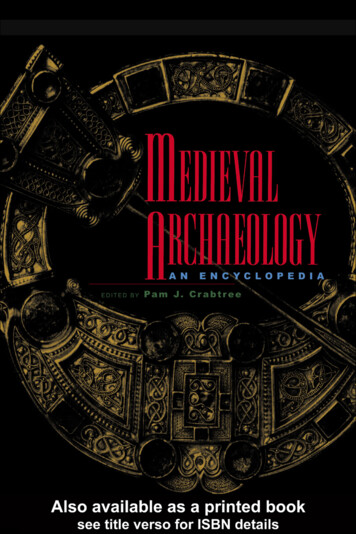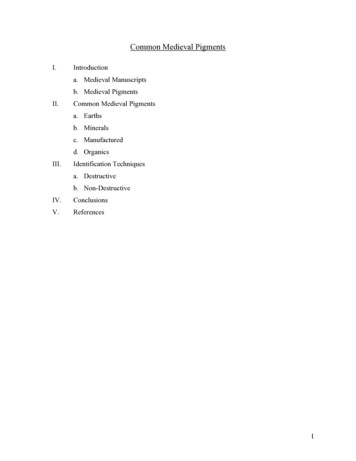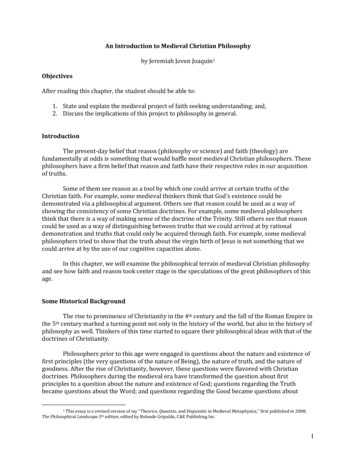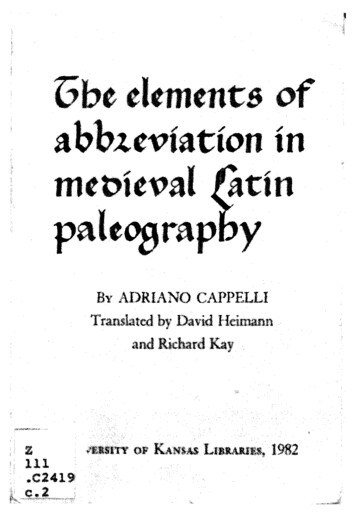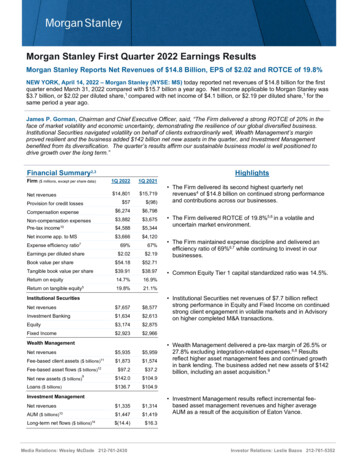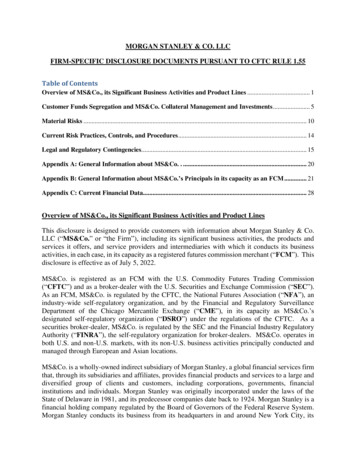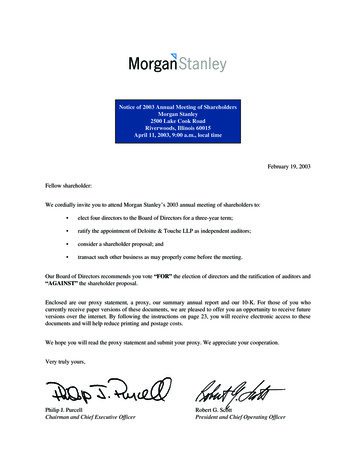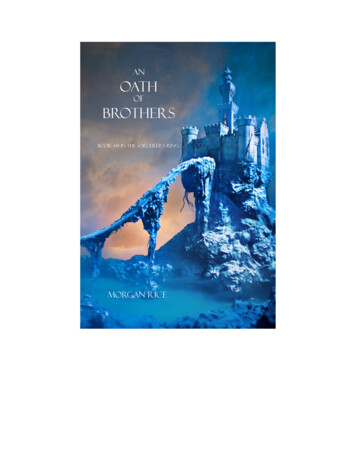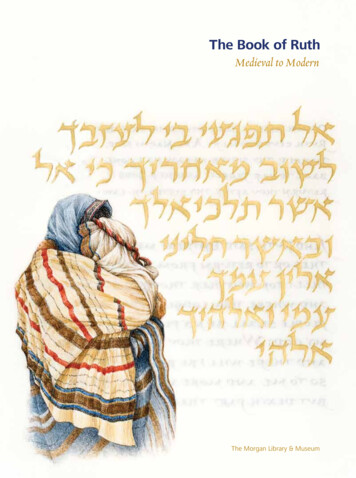
Transcription
The Book of RuthMedieval to ModernThe Morgan Library & Museum
Director’s ForewordFamine and flight. Emigration and immigration. Foreignness. These are someof the societal issues touched upon by the anonymous author of the Bible’sbook of Ruth. The story tells us how hunger drives Naomi and her family fromtheir home. There is famine in the land. Settling abroad, they find food, buttragedy strikes: Naomi’s husband and two sons die unexpectedly. The widowmust return to her people. Ruth, her widowed daughter-in-law, refuses toabandon Naomi and emigrates with her. Ruth is now the stranger in a foreignland. Suspicions run high. Boaz, a relative of Ruth’s late husband and a wealthylandowner, does the right thing: he dutifully marries Ruth, the outsider. Thismarital resolution ultimately results in Ruth’s becoming a great-grandmotherof King David and, in the Christian tradition, an ancestor of Jesus Christ.This exhibition celebrates the gift in 2018 by Joanna S. Rose of the RoseBook of Ruth to the Morgan Library & Museum. The accordion-fold vellummanuscript, measuring nine inches tall but an amazing eighteen feet long, wasdesigned and illuminated by New York artist Barbara Wolff, who worked onthe project for two years (2015–17). The complete biblical text of the book ofRuth is written in Hebrew on one side and in English on the other, the work ofcalligrapher Izzy Pludwinski. The Hebrew side features twenty colored illustrations and a continuous landscape, with accents and lettering in silver, gold, andplatinum; the English side has forty images executed in black ink. The manu script is housed in a modern “treasure binding,” a custom-designed box coveredin shot silk and decorated with 24-karat gold lettering that reads “Your peopleshall be my people and your God shall be my God” in Hebrew. The manuscriptjoins two other creations by Wolff in the Morgan’s collection: You Renew the Faceof the Earth: Psalm 104 and the Rose Haggadah, both gifts of Joanna S. Rose in2014, which were the subject of the 2015 exhibition Hebrew Illumination for OurTime: The Art of Barbara Wolff.The Joanna S. Rose Illuminated Book of Ruth is juxtaposed with twelvemanuscripts drawn from the Morgan’s holdings that unfold the Christian traditions for illustrating the story of Ruth during the Middle Ages. These manuscripts, dating from the twelfth to the fifteenth century, encompass a variety ofgenres: Bibles, in Latin and French; a Speculum humanae salvationis (Mirror ofHuman Salvation); and three leaves from the Morgan’s famed Crusader Bible,the text of which comprises Latin, Persian, and Judeo-Persian inscriptions.Through the conversations between these ancient works and the modern manuscript, visitors will discover how Wolff was inspired by the techniques ofmedieval illumination. Her approach to iconography, however, differs from thatof her medieval forebears. Medieval illuminators illustrated pivotal events inthe biblical narrative by depicting the people involved—mainly Naomi and herfamily, Ruth, and Boaz—arrayed like characters on a stage set.Wolff takes a different approach. On the Hebrew side of her manuscript,she paints few human figures, illustrating instead such elements as a landscape,harvest grains, flowers, a pivotal shoe, and a significant wedding belt to tell thestory. The vignettes on the English side function almost like an archaeologicalgloss to the text, illustrating tools, weights, pottery, and other artifacts typical ofthe early Iron Age, in which the story is set. With no Jewish tradition for illustrating the book of Ruth, Wolff created her own illustrative scheme, one inwhich the characters are evocatively conjured up by the objects they would havetouched, handled, or worn.The Book of Ruth: Medieval to Modern is made possible by Joanna S. Rose, theDavid Berg Foundation, Joshua W. Sommer, and the David Klein, Jr. Foundation.Colin B. BaileyDirector, The Morgan Library & Museum1
An Illuminated Book of RuthThe Hebrew SideJews are known by their books—ancient sagas, collected laws, ethics, philosophy,prayers—words that chronicle a people’s historical journey and mark the passingseasons and festivals of the year. This narrative, the book of Ruth, is a beautifulexample of a story in the Bible told from a woman’s perspective.Most biblical narratives concern kings, priests, and warriors—the lives of men.In the book of Ruth, however, women’s voices speak to us from the world of theearly Iron Age in the Middle East. They tell of lives lived in close contact with thenatural world, dependent on the gifts of sun, rain, and dew, “each in its season.” Inthat ancient setting, women sustained the family, the tribe, and the community.The book of Ruth speaks of courage and devotion. Ruth and Naomi craft themeans of their survival, and their strength helps build the foundation of the HouseA Panorama from Beth-Lechem to Moab to JerusalemThe colored images on the Hebrew side of the Rose Book of Ruth are united by apainted border that, over the course of twenty-four pages, traces the geographic arcof Naomi and Ruth’s story. It follows the journey from a Beth-Lechem (literally, “houseof bread”) in famine to the fertile fields of Moab, and a return to a once again bountiful Beth-Lechem. The border chronicles the grain harvest—ripening barley, awaitingthe reapers and gleaners, and wheat, awaiting harvest under a setting sun. Finally,envisioning a future foretold by the book’s concluding genealogy, it depicts Jerusalem,city of David, set on a hilltop amid the forests of the Judean mountains.of David. Though each chapter has a distinct character, visual language, and ethicalmessage, together they blend into a pastoral narrative set in the springtime ingathering of the grain. While the backdrop of the agricultural setting is a bountiful harvest, the story of Ruth begins with a phrase repeated for thousands of years: “Andthere was famine in the land.” These words reflect the precarious climate of theMiddle East and the vulnerability of its inhabitants.Illuminations and drawings that evoke the atmosphere of each chapter havebeen shaped by rabbinic commentary and folklore, natural phenomena, customsand agricultural practice, the occupations and tools of the people of that time andplace, and the plants and animals familiar to them. The earliest physical form of thebook of Ruth is suggested by its Hebrew title, Megillat Ruth (Scroll of Ruth).Although the text is now read in codex form, the Joanna S. Rose Illuminated Bookof Ruth, with its joined but folded pages, preserves the feeling of a scroll.The silk-covered box binding was designed to allow the manuscript to be read fromeither the Hebrew or English side. The text on the front cover was crafted by master silversmith Joshua Marrow, who fashioned the Hebrew letters from 24-karat gold.23
Perfume and Flowers“Bathe, anoint yourself with perfume,” Naomi advises Ruth. “Dress festively and goDavid to buy the site of a threshing floor from its owner, Ornan,down to the threshing floor and do not reveal yourself to the man until he has fin-and to build there a sacrificial altar. King Solomon, David’sished eating and drinking.” This, she tells her, in preparation for Ruth’s nighttimeson, later builds the Temple of Jerusalem on that site. For me,visit to Boaz.it was but a short distance from the threshing floor to theIn the biblical world of the early Iron Age, ointments and perfumes compounded of oils, aromatic resins, spices, and fragrant flowers were precious andbuilding plan for Solomon’s structure, which I based on a drawing by the greattwelfth-century philosopher Maimonides.reserved for important occasions. I illustrated this passage with some of the plants—almond, lavender, and jasmine, among others—that could have been used to makeWedding BeltRuth’s perfume.The entire community witnesses and blesses Boaz’s declaration that he intends totake Ruth as his wife. In ancient times, Boaz’s public statement of intent before theThe Threshing Floortown would most likely have comprised the entire marriage ceremony.In the narrative, Ruth has her nocturnal encounter with her future husband, Boaz, atRuth’s ornate wedding girdle is based on the festive clothing of Bedouin andBeth-Lechem’s threshing floor, a meeting that changes the direction of the story.Yemenite women—both ancient and modern. Their brightly woven wedding beltsThere are many references to threshing floors in biblical literature, some literal, oth-are sewn with hammered silver ornaments, tinkling silver bells, colored beads, anders symbolic. To mark the end of a plague sent as punishment, God commandscowrie-shell amulets.45
The English SideAlthough written no earlier than the sixth century BCE, the book of Ruth is set in theearly Iron Age, 1200–1000 BCE, the period before the Israelite monarchy or, as thetext says, “In the days when the Judges judged.” The age of the Judges (more precisely, chieftains or military leaders) was a lawless time when there was no king inIsrael and “every man did that which was right in his own eyes.” It is described as anera of crises and intratribal conflict, filled with unease and violence.Against this backdrop of anarchy, the author of the book of Ruth contrasts atale of hesed: of kindness, generosity, loyalty, and of responsibility for the poor, thestranger, the widow. It chronicles the lives of ordinary people in the pastoral settingof the grain harvest.The intent of the pen-and-ink drawings accompanying this English translationis to expand and supplement the illuminations on the Hebrew text. The drawings setthe scene of a small hill town in ancient Israel and the domestic lives of its inhabitants—their surroundings, occupations, customs, and foods.Among the household possessions of the people of Beth-Lechem, one mighthave found a highly polished bronze mirror or a bone comb, a lyre, a beer jug, awooden threshing fork, or a sieve.The Myrtle and GenealogyMyrtle, with its evergreen and delightfully fragrant leaves, has since ancient timesbeen a symbol of the continuity of life, strength, and vitality. With its ability to flourish in adverse conditions, growing stronger and more abundant, the plant is apotent image of survival and renewal. A sprig of myrtle marks the lineage of David,revered king of Israel.The genealogy at the conclusion of the Rose Book of Ruth pays tribute to thosewhose practice of hesed (kindness) made that lineage possible and links the time ofthe Judges (when Ruth’s story took place) to the birth of the Israelite monarchy. Shownhere are the genealogies from both the Hebrew and English sides of the manuscript.67
The Book of Ruth: The Medieval TraditionSummary in a Single InitialIn contrast to the lush illustrations of the Joanna S. Rose Illuminated Book of Ruth, itwas the medieval tradition to give the text of the book of Ruth a single picture. Theelaborate suite of sixteen scenes that unfold in the Morgan’s famous Crusader Bible(discussed below) is a grand exception to this custom.In this leaf from a large, folio-sized Bible from the thirteenth century, however,that single picture—the initial I that commences the biblical text (In diebus uniusjudicis, “In the days of one of the judges”)—summarizes the story’s entire narrativearc. Beginning at the top is Naomi, departing Bethlehem Judah (the name of BethLechem in the Christian tradition) for Moab because of famine (her husband, Elimelech, is not shown). Below, their two sons, Mahlon and Chilion, accompany her. Allthree use walking sticks, medieval emblems of those on a long journey. Beneath theboys are their future wives, Ruth and Orpah. Shown next is Naomi’s return journeyto Bethlehem with her daughter-in-law Ruth following the deaths of Naomi’s husband and two sons. Below them is the depiction of Ruth’s wedding to Boaz. Thenext two images show the fruit of that marriage: their son, Obed, followed by hisson, Jesse, the future father of King David. This series of scenes highlights theimportant role Ruth played as a progenitor of the royal House of David.Ruth’s BackstoryA Woman of ValorDuring the Middle Ages, Bibles and other religious manuscripts followed two mainAlthough the actions of Ruth and Naomi ensured the future Kingdom of Israel,iconographic traditions for the single picture customarily used to illustrate the bookwomen are excluded from the book’s concluding genealogy, an omission I haveof Ruth. One tradition depicted the event described in the text’s opening words:always found unsatisfying. As the creator of this manuscript, I have added (on bothNaomi, her husband, Elimelech, and their two sons, Mahlon and Chilion, departingthe Hebrew and English sides) to this traditional ending the final verses of Proverbs,famine-stricken Bethlehem for Moab. It may strike today’s viewers as odd thatknown as “A Woman of Valor.” Since the sixteenth century, it has been the customRuth—the protagonist of the narrative, who later in the story marries one of Elimel-in some Jewish homes to chant these lines at the beginning of the Sabbath as a cel-ech and Naomi’s sons—is nowhere to be seen in the single picture that illustratesebration of women—their wisdom, courage, and kindness.the book that carries her name. Medieval artists, however, often illustrated the first—Barbara Wolff—8Single leaf from a Bible, in Latin; France, ca. 1260. Gift of the Estateof Belle da Costa Greene, 1951; ms m.851.1, detail.9
Speculum humanae salvationis (Mirror of Human Salvation), in Latin and Dutch; Belgium, Bruges, ca. 1450,illuminated by a Master of the Gold Scrolls. Purchased by Pierpont Morgan, 1909; ms m.385, fols. 28v–29r,Bible, in French; France, Paris, ca. 1275–80, illustrated by the Charlemagne Master and the Paris-details.Acre Master. Purchased by Pierpont Morgan, 1912; ms m.494, fol. 169r, detail.lines of a text they were commissioned to illuminate, and in the opening event ofNaomi on her return to Bethlehem and, entering the city with her, heard her com-the story, Ruth is literally out of the picture.plaint. Although she is not depicted, Ruth’s presence is implied: the first chapter ofThe highly burnished gold illumination in the background of the image,her book is authoritatively cited as the source of the episode—Ruth p[ri]mo typical of the High Gothic era, is of the type that inspires artist Barbara Wolff.cap[itulo]—at the foot of the image.Naomi’s DespairAn Unusually Elaborate CycleThe Mirror of Human Salvation was one of the more popular medieval tracts onIn a rare exception to the medieval norm, the Morgan’s famous Crusader Bibletypology—the theology of identifying people or episodes in the Old Testament ascontains an elaborate Ruth cycle with a suite of sixteen separate scenes spreadprefigurations for people or events of the New Testament. At the far left is the Dep-over five folios. The cycle begins, as does the Joanna S. Rose Illuminated Book ofosition, the moment when the Virgin Mary receives the dead body of Christ fromRuth (see the illustrations on the front and back covers), with Ruth’s refusal tothe cross. As illustrated in the scenes that follow, her great sorrow was prefigured byleave her mother-in-law, Naomi, and their return to Bethlehem Judah together. Itthree Old Testament events: Jacob’s shock upon seeing the bloody coat of his (pre-continues with illustrations of Boaz allowing Ruth to glean in his fields and invitingsumably dead) son Joseph; Adam and Eve’s mourning their murdered son, Abel;her to share a meal with him.and, lastly, Naomi’s lamenting the deaths of her husband and two sons. In the Bible,In the leaf reproduced on page 12, Ruth threshes her gleanings and brings theshe wails, “Do not call me Naomi [beautiful], but call me Mara [bitter].” The two fig-grain to an appreciative Naomi, the second major pictorial tradition in medievalures flanking Naomi represent the women of Bethlehem. Ruth had accompaniedtreatments of the book of Ruth. Upon learning that the field where Ruth has1011
Crusader Bible, added inscriptions in Latin, Persian, and Judeo-Persian; France, Paris, ca. 1250. Purchased byJ. P. Morgan, Jr., 1916; ms m.638, fols. 18r (facing page) and 19r (above), details.gleaned belongs to Boaz, Naomi tells her that he is her kinsman. She counsels Ruthto perfume herself and put on her best garments. In the image at bottom, workersfinish threshing Boaz’s crop as Ruth quietly slips in to where Boaz sleeps and, following Naomi’s instruction, uncovers his feet and lies down. The back of this folio, continuing the narrative, depicts Boaz’s agreeing to marry Ruth.The Ruth cycle in the Crusader Bible concludes in the top register of thefolio shown above. Ruth, now the wife of Boaz, has had a son, Obed. Still abed,she gestures toward Naomi, who gently holds the infant. Prescient neighboringwomen congratulate the family upon the birth of a son who will be the grand father of King David.Marriage of Ruth and BoazThe initial I commencing the book of Ruth in this Bible is illustrated by a rare sceneof Ruth and Boaz in bed. This is their marriage bed, in which they sleep peacefully.(The scene is not to be confused with Ruth’s prostration at the feet of Boaz at thethreshing floor, as seen in the Crusader Bible.) The marriage bed, signifying future1213
Bible, in Latin; Bohemia, Prague or Raudnitz, 1391, illuminated by the Samson Master,the Morgan Master, and others. Purchased in 1950; ms m.833, fol. 88r, detail.progeny and domestic stability, represents the successful resolution of the difficultiesthat Ruth endured in her widowhood and upon her arrival in Bethlehem.Tree of JesseThe Tree of Jesse is the medieval visualization of Isaiah’s prophecy that the Messiahwould spring from the family of Jesse, father of King David. In this detail from atwelfth-century Psalter, the prone Jesse sprouts a vigorous genealogical tree, the firstmember of which, represented by the bust of a crowned man in the lowest roundel,is no doubt David. The top of the tree represents the Christian climax of the genealogy: the Virgin Mary and Jesus Christ. In Christian theology, Ruth played an essentialrole in this lineage as the mother of Jesse’s father, Obed; as the great-grandmotherof David, Ruth is thus also an ancestor of the Savior.Leaf from the Eadwine Psalter; England, Canterbury, Christ Church Priory, ca. 1150. Purchased in 1927; ms m.724v, detail.—Roger S. Wieck—1415
Barbara WolffNew York artist Barbara Wolff, one of today’s foremost illuminators and illustrators, hasexhibited at New York’s Society of Illustrators, the Jewish Theological Seminary, YeshivaUniversity Museum, the Museum of Biblical Art, the Jewish Museum of Prague, and theMorgan Library & Museum. She has produced several films on the techniques ofmanuscript illumination: The Prato Haggadah: Making of a Manuscript for the JewishTheological Seminary; An Illumination in the Rothschild Miscellany for the Israel Museum;and Creating the Rose Haggadah: An Illuminated Manuscript for the 21st Century andYour People Shall Be My People for the Morgan Library & Museum.Izzy PludwinskiCalligrapher Izzy Pludwinski is a freelance calligrapher and teacher of calligraphy who livesin Jerusalem. He studied at the Roehampton Institute in London. He has establishedHebrew calligraphy courses in both Jerusalem and London and lectured at the EmunahCollege Symposium. His various commissions include special-edition Haggadot, work forthe Israeli President’s Office, a fine edition of the Song of Songs, and Hebrew lettering forthe St. John’s Bible. He is responsible for both the Hebrew and English calligraphy in theJoanna S. Rose Illuminated Book of Ruth.Published to accompany an exhibition at the MorganLibrary & Museum, 14 February to 14 June 2020.The Book of Ruth: Medieval to Modern is made possibleby Joanna S. Rose, the David Berg Foundation, Joshua W.Sommer, and the David Klein, Jr. Foundation. 2020 The Morgan Library & Museum. All rightsreserved. No part of this publication may be reproducedor transmitted in any form or by any means, electronicor mechanical, including photocopy, recording, or anyother information storage and retrieval system, withoutprior permission in writing from the publisher.All text and artwork by Barbara Wolff 2020 BarbaraWolff. Photography by Rudi Wolff.Photography: Janny Chiu, pp. 10–11, 14; Graham S.Haber, pp. 9, 12–13, 15, back cover; Rudi Wolff, frontcover, pp. 2–8, 16.Designed by Bessas & AckermanPrinted by Tangent GraphicsFront cover: Naomi and Ruth Embracing, from theJoanna S. Rose Illuminated Book of Ruth, in Hebrewand English; New York and Jerusalem, 2015–17, designedand illuminated by Barbara Wolff. Gift of Joanna S. Rose,2018; ms m.1210, fol. 7r, detail.Back cover: Orpah Demurs While Ruth Joins Naomi, fromthe Crusader Bible, added inscriptions in Latin, Persian,and Judeo-Persian; France, Paris, ca. 1250. Purchased byJ. P. Morgan, Jr., 1916; ms m.638, fol. 17r, detail.Still frames from Your People Shall Be My People: applying silver leaf and writing Hebrew calligraphy.The Morgan Library & Museum225 Madison AvenueNew York, NY 10016www.themorgan.org16
book of Ruth. The story tells us how hunger drives Naomi and her family from their home. There is famine in the land. Settling abroad, they find food, but tragedy strikes: Naomi's husband and two sons die unexpectedly. The widow must return to her people. Ruth, her widowed daughter-in-law, refuses to abandon Naomi and emigrates with her.
